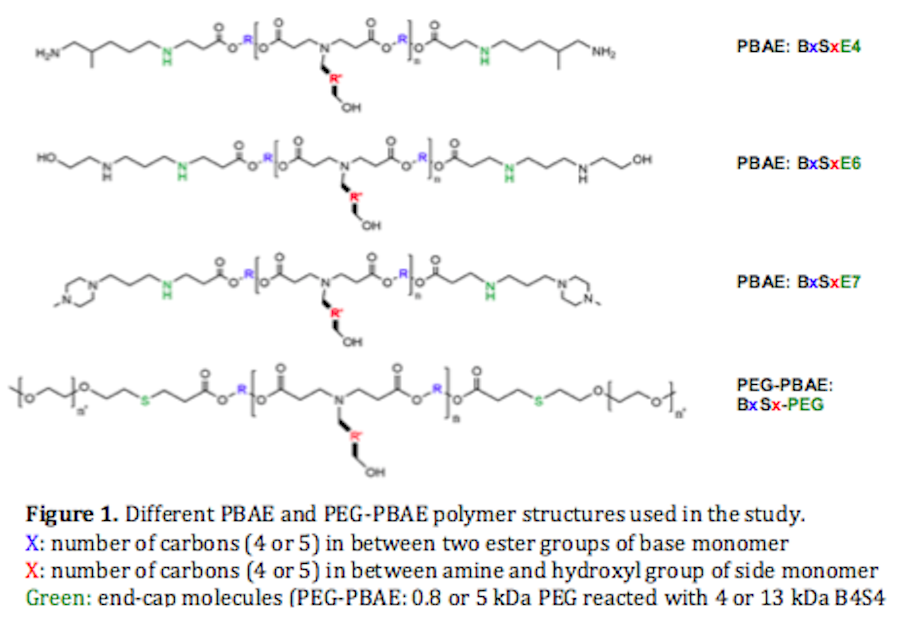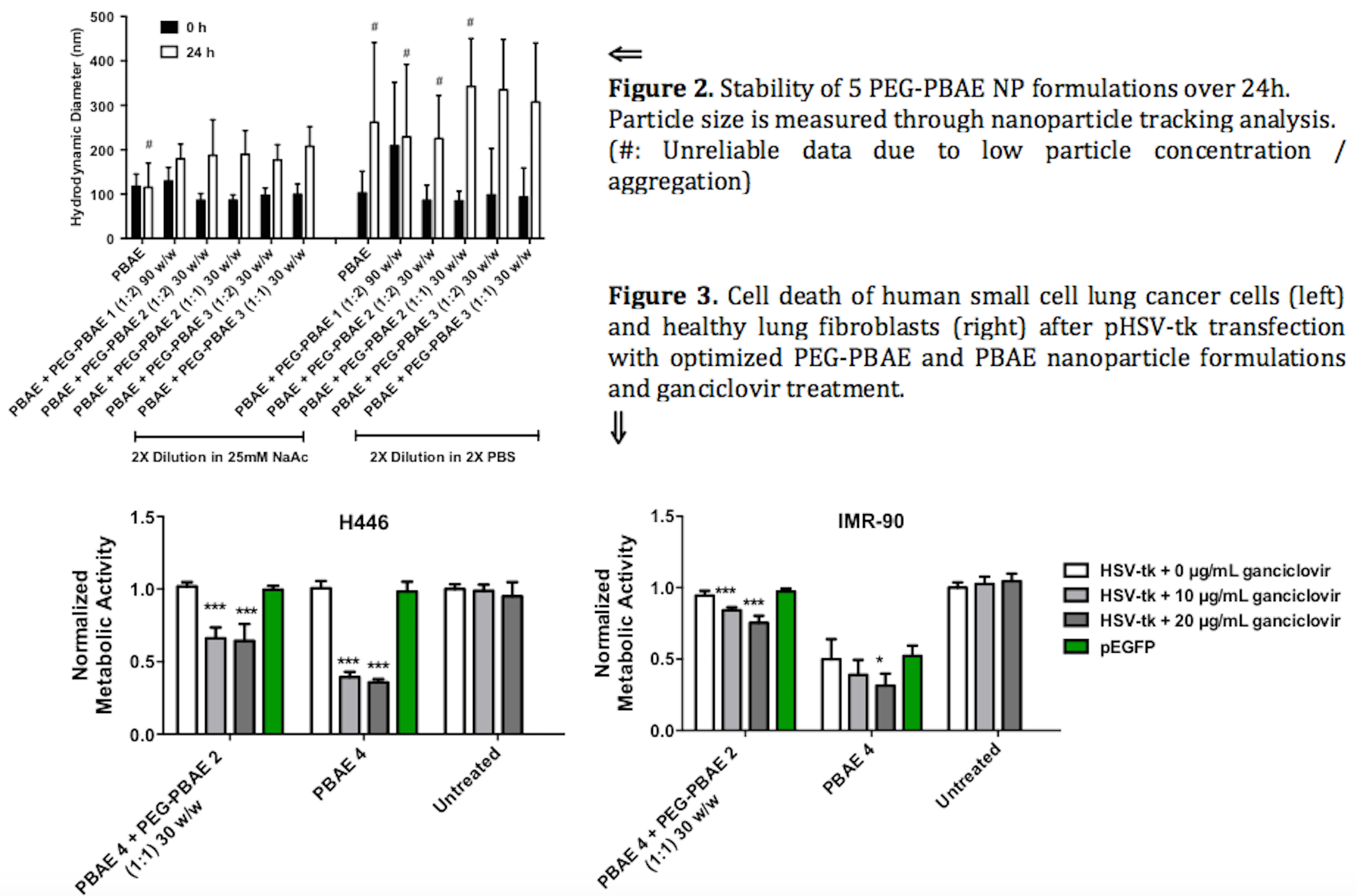Introduction: We engineered polymeric gene delivery nanoparticles to identify enhanced formulations for cancer gene therapy. Poly(β-amino ester)s (PBAEs) are non-viral, biodegradable polymers that condense DNA to form nanoparticles. PBAEs with different structures can be synthesized from a library of monomers and small molecules to be safe and effective for in vitro gene delivery[1]. However, these nanoparticles need further optimization for in vivo applications in order to prevent particle aggregation, increase systemic half-life, enhance diffusion through biological tissues, and improve transfection[2]. To this end, we synthesized novel poly(ethylene glycol)-conjugated PBAE polymers (PEG-PBAE) and utilized a combinatorial approach to optimize PBAE/PEG-PBAE/DNA nanoparticles that exhibit enhanced stability and efficacy.
Materials and Methods: A two-step Michael addition reaction was used to synthesize an array of 9 conventional PBAE polymers as previously described[3]. To synthesize four types of PEG-PBAE polymer, amine-catalyzed thiol-ene Michael addition reaction was used to conjugate PEG-thiol molecules of two different molecular weights to a specific PBAE backbone polymer of two different molecular weights (Fig. 1). Nanoparticles were formulated with a blend of PBAE and PEG-PBAE at three PBAE:PEG-PBAE (2:1, 1:1, 1:2) and three total polymer:DNA (30, 60, 90 w/w) weight ratios. These nanoparticles were sequentially measured for particle size at 0 and 24 h by Nanosight NS500 and for transfection efficacy of pEGFP by flow cytometry. MTS assay was used to compare cell death caused by delivering Herpes Simplex Virus thymidine kinase (pHSV-tk) using the most optimal formulation followed by two ganciclovir treatments to human lung cancer cells (H446) and healthy lung fibroblasts (IMR-90).

Results and Discussion: First, 36 different combinations of PEG-PBAE nanoparticles were formulated using a single type of PBAE (B4S4E7) and tested for stability. The representative data showed initial particle size for most nanoparticles to be 90 - 110 nm, and four PEG-PBAE formulations that retained sub-200 nm size after 24 h in 25 mM NaAc were selected for further screening (Fig. 2). Then, 18 different PBAE nanoparticles utilizing nine PBAEs of different structures and two polymer:DNA weight ratios (60 and 75 w/w) were tested for transfection efficacy, and the four best performing PBAE structures were selected. Lastly, transfection evaluation of 16 PEG-PBAE nanoparticles formulated with polymer structures that demonstrated enhanced stability and transfection was performed. The highest transfection was from nanoparticles composed of a blend of PBAE 4 (B4S5E7) with PEG-PBAE 3 (5 kDa PEG - 4 kDa B4S4 PBAE) at a 1:1 weight ratio and with a total polymer:DNA weight ratio of 30 w/w. This nanoparticle formulation showed cancer specificity, killing 35% of the human lung cancer cells, compared to 15% in healthy lung fibroblasts with pHSV-tk and ganciclovir treatment (Fig. 3).

Conclusions: A combinatorial approach was used to formulate PBAE nanoparticles with a novel PEG-PBAE polymer. The optimized formulation showed sub-300 nm in size after 24 h incubation, while maintaining high transfection efficacy and function in human small cell lung cancer cells. These results show great potential for not only its evaluation in vivo but also the combinatorial methodology toward discovering new biomaterial platforms.
Samsung Scholarship; NIH 1R01EB016721; Wilmer Core Grant (P30-EY001865, Imaging and Microscopy Core Module)
References:
[1] Green, J.J., Langer, R., Anderson, D.G. A combinatorial polymer library approach yields insight into nonviral gene delivery. Acc Chem Res. 2008, 41(6):749-59.
[2] Kim, J., Wilson, D.R., Zamboni, C.G., Green, J.J. Targeted polymeric nanoparticles for cancer gene therapy. J Drug Target. 2015, 10:1-15.
[3] Kamat, C.D., Shmueli, R.B., Connis, N., Rudin, C.M., Green, J.J., Hahn, C.L. Poly(β-amino ester) nanoparticle delivery of TP53 has activity against small cell lung cancer in vitro and in vivo. Mol Cancer Ther. 2013,12(4):405-15.